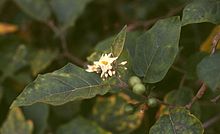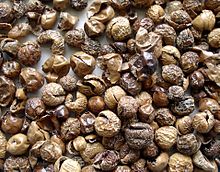- Solanum torvum
-
Turkey Berry 
Scientific classification Kingdom: Plantae (unranked): Angiosperms (unranked): Eudicots (unranked): Asterids Order: Solanales Family: Solanaceae Genus: Solanum Species: S. torvum Binomial name Solanum torvum
Sw.Synonyms Solanum ferrugineum Jacq.
Solanum mayanum Lundell
Solanum verapazense Standl. & Steyerm.- List source :[1] For more see "Synonyms and systematics" section below.
Solanum torvum (Turkey Berry), is a bushy, erect and spiny perennial plant used horticulturally as a rootstock for eggplant. Grafted plants are very vigorous and tolerate diseases affecting the root system, thus allowing the crop to continue for a second year.
It is also known as Devil's Fig, Prickly Nightshade, Shoo-shoo Bush, Wild Eggplant, Pea Eggplant, Pea Aubergine, susumba, boo, terongan, tekokak, berenjena cimarrona, berenjena de gallina, berenjena silvestre, tabacón, pendejera, tomatillo, bâtard balengène, zamorette, friega-platos, sundaikkai (Tamil: சுண்டைக்காய்), makhua phuang (Thai: มะเขือพวง), and many other names (Howard 1989, Little and others 1974, Pacific Island Ecosystems at Risk 2001).
Contents
General description
The plant is usually 2 or 3 m in height and 2 cm in basal diameter, but may reach 5m in height and 8 cm in basal diameter. The shrub usually has a single stem at ground level, but it may branch on the lower stem. The stem bark is gray and nearly smooth with raised lenticels. The inner bark has a green layer over an ivory color (Little and others 1974). The plants examined by the author, growing on firm soil, had weak taproots and well-developed laterals. The roots are white. Foliage is confined to the growing twigs.
The twigs are gray-green and covered with starshaped hairs. The spines are short and slightly curved and vary from thick throughout the plant, including the leaf midrib, to entirely absent. The leaves are opposite or one per node, broadly ovate with the border entire or deeply lobed. The petioles are 1 to 6 cm long and the blades are 7 to 23 by 5 to 18 cm and covered with short hairs. The flowers are white, tubular with 5 pointed lobes, and grouped in corymbiform cymes. They are shed soon after opening.
The fruits are berries that grow in clusters of tiny green spheres (ca. 1 cm in diameter) that look like green peas. They become yellow when fully ripe. They are thin-fleshed and contain numerous flat, round, brown seeds (Howard 1989, Liogier 1995, Little and others 1974).
Range
Turkey berry apparently is native from Florida and southern Alabama through the West Indies and from Mexico through Central America and South America through Brazil (Little and others 1974). Because of its rapid spread as a weed in disturbed lands, it is difficult to tell which populations are native and which are introduced. Turkey berry has been introduced and naturalized throughout tropical Africa, Asia, Australia, and the Pacific Islands including Hawaii, Guam, and American Samoa (Pacific Island Ecosystems at Risk 2001).
Ecology
In Puerto Rico, turkey berry grows in upland sites that receive from about 1000 to 4000 mm of annual precipitation. It also grows in riparian zones in drier areas. Turkey berry grows on all types of moist, fertile soil at elevations from near sea level to almost 1,000 m in Puerto Rico (Little and others 1974) and 2,000 m in Papua New Guinea (Pacific Island Ecosystems at Risk 2001). Given an equal start after disturbance, turkey berry quickly overtops most herbs, grasses, and other shrubs. It grows best in full sunlight and does well in light shade or shade for part of the day, but cannot survive under a closed forest canopy. Turkey berry single plants, groups, and thickets are most frequently seen on roadsides, vacant lots, brushy pastures, recently abandoned farmland, landslides, and river banks.
Reproduction
Flowering and fruiting is continuous after the shrubs reach about 1 to 1.5 m in height. Ripe fruits collected in Puerto Rico averaged 1.308 + 0.052 g. Air dry seeds from these fruits weighed an average of 0.00935 g or 1,070,000 seeds/kg. These seeds were sown on commercial potting mix and 60 percent germinated between 13 and 106 days following sowing. The seedlings are common in recently disturbed ground. Frugivorous birds eat the fruits and spread the seeds (Pacific Island Ecosystems at Risk 2001). Turkey berry can be propagated vegetatively by placing branch cuttings, with or without leaves, in a mist chamber for one month (Badola and others 1993).
Growth and management
Turkey berry grows about 0.75 to 1.5 m in height per year. The species is not long-lived; most plants live about 2 years. Physical control of the shrub may be done by grubbing out the plants; lopping will not kill them. They can be killed by translocated herbicides applied to the leaves or the cut stumps (Pacific Island Ecosystems at Risk 2001).
Gastronomy
The green fresh fruits are edible and used in Thai cuisine, being one of the essential elements of the Thai yellow curry.[2] They are also used in Lao cuisine (Royal Horticultural Society 2001).
The fruits are incorporated into soups and sauces in the Ivory Coast (Herzog and Gautier-Béguin 2001).
In Tamil Nadu, India, the fruit is consumed directly, or as cooked food like Sundaikkai Sambar, Sundaikkai Poriyal, Sundaikkai Aviyal & Sundaikkai Pulikulambu. After soaking in curd and drying, the final product is fried in oil as Sundaikkai vattral (available in all Tamil Nadu supermarkets), it is famous all around in Tamil Nadu. In siddha medicine on of the traditional systems of India Sundaivattral Choornam is used to improve digestion.
Other uses
The wood is soft and light and of little use except for emergency fuel.
Turkey berry contains a number of potentially pharmacologically active chemicals including the sapogenin steroid, chlorogenin (Badola and others 1993). Aqueous extracts of turkey berry are lethal to mice by depressing the number of erythrocytes, leukocytes and platelets in their blood (Tapia and others 1996). A related chemical, cholecalciferol, is the active ingredient in a number of commercial rodentacides (American Board of Veterinary Toxicology 2001). Extracts of the plant are reported to be useful in the treatment of hyperactivity (Null 2001), colds and cough (CPR Environmental Education Centre 2001), pimples, skin diseases, and leprosy (Liogier 1990). Turkey berry is being crossed with eggplant in an attempt to incorporate genes for resistance to Verticillium wilt into the vegetable (Bletsos and others 2001).
Synonyms and systematics
Several other Solanum species have at one time been included in S. torvum as subspecies or varieties:[3]
- Solanum bahamense of Carl Linnaeus (as var.? persicifolium)
- Solanum chrysotrichum of von Schlechtendal (as var. pleiotomum)
- Solanum ferrugineum (as var. ferrugineum, var. hartwegianum)
- Solanum lanceolatum of Cavanilles (as var. schiedeanum)
- Solanum macaonense (as var. lasiostylum)
- Solanum rudepannum (as var. fructipendulum, var. ochraceo-ferrugineum)
- Solanum scuticum (as ssp./var. brasiliense, var. daturifolium, var. genuinum)
Also, a number of more or less ambiguous and now-invalid names have been used for S. torvum:
- Solanum acanthifolium Hort. Par. ex Dunal, in DC. (non Mill.: preoccupied)
- Solanum acanthifolium of Philip Miller is S. campechiense as described by Carl Linnaeus.
- Solanum campechiense Hort. Par. ex Dunal, in DC. (non L.: preoccupied)
- Solanum crotonoides Michx. ex Dunal, in DC. (non Lam.: preoccupied)
- Solanum crotonoides of Sieber from Presl is S. lanceifolium as described by von Jacquin.
- Solanum ficifolium Ortega
- Solanum heterophyllum Balb. ex Dunal, in DC. (non Lam.: preoccupied)
- Solanum heterophyllum of Lamarck is S. subinerme
- Solanum largiflorum C.T.White
- Solanum maccai Bertero ex Dunal, in DC. (non Dunal in Poir.: preoccupied)
- Solanum maccai of Dunal in Poiret is S. stramoniifolium as described by von Jacquin.
- Solanum mammosum Herb. ex Dunal, in DC. (non L.: preoccupied)
- Solanum mammosum of Pavón Jiménez from Dunal in de Candolle is S. circinatum.
- Solanum mannii C.H.Wright
- Solanum mannii var. compactum of C.H. Wright is S. anomalum.
- Solanum mayanum Lundell
- Solanum sanctum Jan ex Dunal, in DC. (non L.: preoccupied)
- Solanum sanctum of Carl Linnaeus is S. incanum as described by the same author.
- Solanum torvum var. typicum Hochr. (nom. illeg)
See also
- Pagit-pagit
Footnotes
- ^ "Name - Solanum torvum Sw. synonyms". Tropicos. Saint Louis, Missouri: Missouri Botanical Garden. http://www.tropicos.org/Name/29600147. Retrieved February 19, 2010.
- ^ Pee eggplant
- ^ Solanaceae Source [2008]
References
- Solanaceae Source [2008]: Solanum torvum. Retrieved 2008-SEP-25.
Categories:- Eggplants
- Thai ingredients
- Lao ingredients
- Flora naturalised in Australia
- Invasive plant species
Wikimedia Foundation. 2010.

